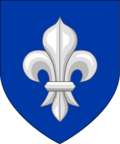President of Azmara
| President of Azmara | |
|---|---|
| Forsiter âb Azmaara | |
 Coat of Arms of the Commonwealth of Azmara | |
 Flag of the Commonwealth of Azmara | |
| Style | The Honourable (diplomatic, outside Azmara) |
| Status | Head of state |
| Residence | Eleinasburg Castle |
| Seat | Eleinasburg, Aalmsted, Azmara |
| Appointer | Direct popular vote |
| Term length | Six years, renewable once |
| Precursor | King of Azmara |
| Formation | 19 October 1855 |
| First holder | Mikel Hankssun |
| Salary | €150,000/year |
| Website | www |
The President of Azmara (Azmaran: Forsiter âb Azmaara) is the head of state of the Commonwealth of Azmara and the commander-in-chief of the Armed Forces of the Commonwealth of Azmara. The President is elected to serve for a six-year term and is allowed to serve up to two terms.
The position was created in the Basic Law of 1855 as the head of state and government following the establishment of a republic in Azmara. While it initially held supreme executive power, many of its powers were transferred to the newly-created position of Thingspeaker in 1915, with further restrictions being placed on the role in 1933 rendering it a largely ceremonial position.
The President officially resides as Eleinasburg Castle in Aalmsted. The current President of Azmara is Maarija Ryginsdohter, who took office on 15 September 2015 following the 2015 election.
History
Election
The procedure of the President's election is laid out in Articles 7-10 of the Basic Law of the Commonwealth of Azmara. Article 7 bestows the power of election to the people of Azmara and specifies instant runoff voting as the method of election, with voters being required to rank candidates and a candidate requiring a majority of votes to be elected. Article 8 places eligibility requirements on the position, limiting it to Azmaran citizens over the age of 25 and requiring candidates to get signatures from 250 other citizens of Azmara to get onto the ballot.
Article 9 limits the President to two terms in office while Article 10 requires the President swear to uphold the values of the constitution and to give up all previous political affiliations to ensure impartiality.
Powers
The powers of the President are largely governed by Articles 11-14 of the Basic Law.
The first two articles establish the position's relationship with the legislature. Article 11 designates the President as an official mediator between the different branches of government and tasks them with breaking a potential gridlock between the two chambers of the Alþing or between the Alþing and the Government. Article 12 gives the President the power of signing into law bills passed by the Alþing and the power to officially dissolve the Folksmot for new elections after it votes to do so or when its term is finished, while making it a requirement to perform these duties four weeks after a bill is passed or dissolution is requested.
Articles 13 and 14 establish the President's powers over foreign affairs. Article 13 places the President in the role of commander-in-chief and gives them the power to declare war on other states after the Folksmot votes to do so or to summon the Folksmot after another country declares war on Azmara, while Article 14 establishes them as the chief diplomat of Azmara and makes them responsible for appointing diplomats to other countries and receiving diplomats from other countries.
While not explicitly mentioned in the Basic Law, the President is by custom required to officially swear in members of the Government, while the official power to appoint and dismiss a Thingspeaker and their government is given to the Folksmot through motions of confidence.
Removal and succession
Article 15 of the Basic Law specifies the procedure through which a President may be removed. If the President fails to uphold their constitutional duties, a joint session of the Alþing may be called and the President removed from office if an absolute majority of three-fifths of members vote to remove them.
Article 16 specifies the succession process for a President that dies, resigns or is removed from office - the Landsmot elects one of its members to serve as interim President and calls an election for no less than eight weeks after the President's death, resignation or removal.
No President has been removed from office since the enactment of the Basic Law of 1933, with Article 15 having only been invoked once in 1973 after President Leif Alekssun's refusal to sign into law a bill legalising contraception, yet Alekssun resigned as President before the Alþing could meet.
Salary and residence
The officeholder is currently bestowed a salary of €150,000/year as per the Government Salaries Act of 2016. The President is also given Eleinasburg Castle, a minor residence of the House of Ryksmark-Halte-Haldorf nationalised by the government after the Revolution located in the Aalmsted borough of Eleinasburg, as an official residence.
